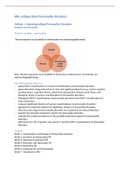Alle colleges blok Personality disorders
College 1. Openingscollege Personality Disorders
Suzanne van Bronswijk
Theorie – praktijk – wetenschap
Doel: theorie toepassen op de praktijk en die kunnen ondersteunen met behulp van
wetenschappelijk bewijs
Intended learning outcomes
- apply DSM-5 classifications to various manifestations of personality disorders;
- apply alternative diagnostic points of view and significant theories (e.g., psycho-analysis,
learning theory, cognitive theory, attachment perspective, interpersonal theory and
biological views) to various manifestations of personality disorders;
- distinguish DSM-5 classifications of personality disorders from DSM-5 classifications of
clinical disorders;
- compare significant theories of various manifestations of personality disorders;
- appraise the empirical evidence of significant theories of personality disorders;
- determine the impact of personality disorders on treatments for clinical disorders;
- examine the possible treatments options for personality disorders;
- evaluate the empirical evidence of the possible treatments options for personality
disorders;
- determine the role of gender and culture in specific DSM-5 classifications of personality
disorders
Tutorials
Week 1: Classification and Etiology of Personality Disorders
Week 2: Avoidant and Dependent PD
Week 3: Obsessive-compulsive PD
Week 4: Histrionic and Narcissistic PD
Week 5: Borderline PD
Week 6: Antisocial PD and Psychopathy
Week 7: Treatment in PDs
,Lezingen
Week 1: Openingscollege (Suzanne van Bronswijk & Stefanie Duijvis) live online lezing
Week 2: Cluster C persoonlijkheidsstoornissen (dr. Maarten Peters) pre-recorded
Cluster C persoonlijkheidsstoornissen (dr. Maarten Peters) live online Q&A
Week 4: Schema Therapy (prof. dr. David Bernstein) pre-recorded
Week 5: Schema Therapy (prof. dr. David Bernstein) live online Q&A
Borderline PD (dr. Linda van Zutphen) pre-recorded
Week 6: Antisocial PD and Psychopathy (dr. Jill Lobbestael) pre-recorded
Borderline PD (dr. Linda van Zutphen) live online Q&A
Week 7: Reponse college* (Suzanne van Bronswijk) live online lezing
Aanwezigheid
Tutorials:
- Ten minste 5 bijeenkomsten
- Afmelding via tutor
- Geen inhaalopdrachten
Lezingen (online)
- Aanwezigheid bij live online lezingen en Q&A
- Lezingen (inclusief de Q&A Vragen) zijn onderdeel van het examen
Tutorials
- Alleen nabesprekingen (CANVAS modules leerdoelen per week)
- Voorbereiding (CANVAS modules en CANVAS resources)
Clinical cases (taak 2 t/m 6)
Videos + vragen
Leerdoelen
- Nabespreken
Geen rijtjes!
1/2 studenten bereiden vragen videos voor
Leerdoelen + quizes
Tabel invullen (taak 2 t/m 6)
Examen
Doel: theorie kunnen toepassen op de praktijk en onderbouwen met wetenschappelijk
bewijs
Format: 6 open boek vragen, 3 uur, via testvision
Vraag: is dit onderdeel van te toets?
Antwoord: ja alle literatuur/lezingen/quizzes/video(vragen)/clinical cases zijn bronnen voor
de open boek toets. Je moet de inhoud kunnen begrijpen en kunnen toepassen op klinische
en theoretische vraagstukken (en dit op de juiste wijze citeren).
Scid-5-p training
Doel training
- Kennis opdoen van wat persoonlijkheidsstoornissen zijn
- De diagnostiek van persoonlijkheidsstoornissen leren begrijpen
- Persoonlijkheidsstoornissen grotendeels kunnen classificeren mbv de scid-5-p
,- Een crisisplan leren opstellen in samenwerking met de betrokkenen
- Passende interventies kunnen uitvoeren ten tijde van een crisissituatie
Inhoud scid-5-p training
- 1e bijeenkomst: een prerecorded college
- 2e bijeenkomst: cluster C-persoonlijkheidsstoornissen
- 3e bijeenkomst: cluster-B persoonlijkheidsstoornissen
- 4e bijeenkomst: cluster-A persoonlijkheidsstoornissen
- 5e bijeenkomst: SPC
- 6e bijeenkomst: een crisisplan maken
- 7e bijeenkomst: Crisis workshop
Praktische zaken
- De training is on campus
- 100% aanwezigheidsverplichting
- Bij ziekte: inhaalopdracht
- Trainingsgroep in 3 subgroepen (A, B en C) verdelen. Elke subgroep fungeert tijdens de
bijeenkomst 2 t/m 4 als een literatuurgroep, casusgroep of oefengroep.
, College 2. Schema therapy for personality disorders
David Bernstein
Why do people with Personality Disorders come for treatment?
Mensen met een persoonlijkheidsstoornis hebben vaak niet in de gaten dat ze een probleem
hebben: egosyntonic. Vooral mensen om hen heen zullen deze problematische personality
traits inzien en daar last van hebben. Wanneer mensen met een persoonlijkheidsstoornis
voor hulp zoeken, is dit dan vaak ook voor andere redenen/problemen:
- Acute Axis I problems (e.g., substance abuse, depression, anxiety disorders)
- Life crises (e.g., marital, financial, legal problems)
- Coerced into treatment (e.g., spouse threatens divorce)
- Feeling “stuck” in repetitive patterns that they don’t understand
- Rarely is a Personality Disorder seen as the “presenting problem”
Personality Disorders and treatment outcome
- Personality disorder patients appear to show worse outcomes for a variety of Axis I
disorders, including mood disorders and anxiety disorders.
- However, it is not entirely clear whether this is partially a function of their more severe
psychopathology, or of personality disorders themselves
Mensen met persoonlijkheidsstoornissen hebben een hogere drop out rate
Limitations of Usual Therapeutic Approaches with Personality Disorder Patients
- Many clients with personality disorders don’t follow treatment prescriptions, because
their personality disorders interfere with their ability or willingness to carry out
“homework” assignments.
- Standard cognitive and behavioral interventions may feel abstract and irrelevant to
clients whose deeper issues concern their feelings about themselves and their
relationships with other people.
What makes personality disorders so difficult to treat using standard methods?
Personality Disorders are Self-Defeating
- Personality disorders involve self-defeating and self-destructive patterns of behavior
- Personality disorder clients are often unaware of their difficult traits, or see no need to
change them; their behavior is “ego-syntonic”
- They avoid forming attachments, or drive people away with their frustrating, hostile, or
intimidating behavior
- Personality disorders undermine our ability to empathize with those who have them.
- The result is that personality disorder clients often don’t receive the help they need,
perpetuating their problems
For patients with personality disorders, alternative therapeutic approaches are often needed
Schema Therapy
- An integrative form of psychotherapy for personality disorders and other difficult-to-
treat problems (e.g., chronic mood or anxiety disorders)
- Combines cognitive, behavioral, psychodynamic, and experiential approaches





